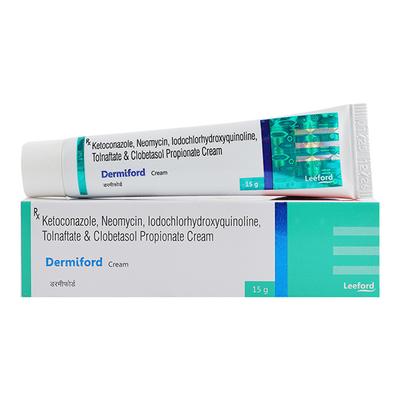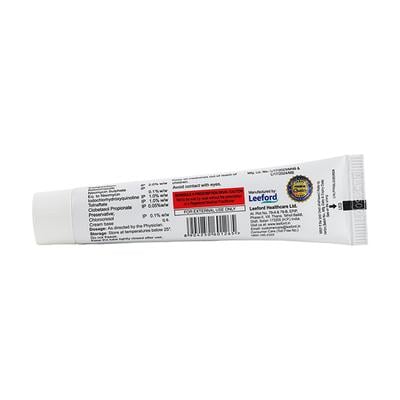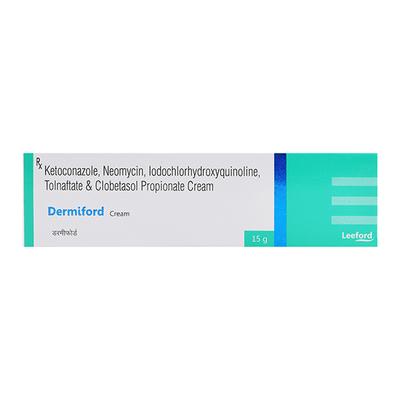

Netmeds First Membership
Quick Links
Introduction About DERMIFORD CREAM
DERMIFORD CREAM is used in the management of bacterial and fungal skin infections and inflammation. It contains a combination of antibacterial and antifungal agents Clobetasol, Iodochlorhydroxyquinoline, Ketoconazole, Neomycin and Tolnaftate which effectively reduces microbial growth on the skin and manages further spread of infection.
Apply DERMIFORD CREAM as advised by your doctor. It is for external use only. Apply a thin layer of this medicine to the affected areas of the skin and rub in gently as directed by the doctor. Wash your hands after using the medicine.
DERMIFORD CREAM should be used in pregnant women only if it is clearly necessary. Inform your doctor if you are pregnant or planning to become pregnant before using this medicine.
DERMIFORD CREAM should be used with caution in breastfeeding women. Consult your doctor before using it.
DERMIFORD CREAM is not recommended for use in children under 2 years of age. Consult the child’s doctor for advice.
The most common side effects of using DERMIFORD CREAM are skin irritation, itching, pain, burning or stinging sensations, dry skin, skin eruptions, etc. Consult your doctor if any of the side effects worsen.
Uses Of DERMIFORD CREAM
- To manage skin infections and inflammation
How DERMIFORD CREAM Works
DERMIFORD CREAM helps manage skin infections. Clobetasol is a corticosteroid that helps relieve itching, redness, and swelling. Iodochlorhydroxyquinoline and neomycin are antibiotic and antiprotozoal agents that relieves bacterial and protozoal infections. Tolnaftate and ketoconazole are antifungal agents that help manage fungal skin infections. Collectively, DERMIFORD CREAM helps in managing skin infections and inflammation.
How to use DERMIFORD CREAM
Apply DERMIFORD CREAM as advised by your doctor. It is for external use only. Apply a thin layer of this medicine to the affected areas of the skin and rub in gently as directed by the doctor. Wash your hands after using the medicine. Your doctor will decide the correct dose and duration for you depending on your age, condition, and body weight. Avoid contact with the eyes.
Side Effects Of DERMIFORD CREAM
Common
- skin irritation or itching
- pain
- burning or stinging sensation
- dry skin
- skin eruptions
Uncommon
- localized eczema (dermatitis)
- skin rash
- sticky skin
- prickling sensation
- discomfort
- bleeding or other reactions at the application site
- skin thinning, causing stretch marks
Stop applying DERMIFORD CREAM and inform your doctor immediately if you experience any of the following side effects:
- Extreme hair growth, skin thinning or discoloration, acne, stretch marks, and small red bumps on the skin (folliculitis)
- Symptoms of allergic reactions such as rash, itching, sweeling of the face, tongue, and throat, causing difficulty breathing, and severe dizziness.
How To Manage Side Effects
Skin rash Or Itching
Avoid hot baths because hot water can irritate your skin further. Do not scratch the affected area. Use sunscreen and wear protective clothing while going outside. Regularly moisturize your skin to soothe and hydrate the affected area. Contact your doctor if your skin irritation worsens.
Warning & Precautions
Pregnancy
Monitoring requiredDERMIFORD CREAM should be used in pregnant women only if it is clearly necessary. Inform your doctor if you are pregnant or planning to become pregnant before using this medicine.
Breastfeeding
Use with CautionDERMIFORD CREAM should be used with caution in breastfeeding women. Consult your doctor before using it.
Allergy
ContraindicatedDo not take DERMIFORD CREAM if you are allergic to Clobetasol, Iodochlorhydroxyquinoline, Ketoconazole, Neomycin, Tolnaftate, or any of the other ingredients in this medicine.
Use In Pediatrics
ContraindicatedDERMIFORD CREAM is not recommended for use in children under 2 years of age. Consult the child’s doctor for advice.
Use In Geriatrics
Use with CautionDERMIFORD CREAM should be used with caution in elderly patients. Consult your doctor before using it.
Others
Before taking DERMIFORD CREAM, inform your doctor if you:
- have tuberculosis of the skin
- have viral skin or eye infections
- have problems with your immune system
- have poor blood circulation
- have broken or damaged skin
- have psoriasis
- have a chronic leg ulcer
Interactions
A. Drug-Drug Interactions:
Inform your physician if you are taking any of the following drugs before taking DERMIFORD CREAM:
- ritonavir (antiviral)
- itraconazole (antifungal)
Overdosage:
If you or anyone else accidentally swallows too much DERMIFORD CREAM, consult your doctor immediately or visit the nearby hospital.
Synopsis
| Drug | : | Clobetasol, Iodochlorhydroxyquinoline, Ketoconazole, Neomycin, and Tolnaftate |
| Pharmacological Category | : | Corticosteroids, Antibiotics and antiprotozoals, Antifungals, Antibiotics, and antifungals |
| Therapeutic Indication | : | Skin infections |
| Dosage Forms | : | Cream |
More Information
- Keep DERMIFORD CREAM out of reach of children
- Store at room temperature below 25°C
FAQs About DERMIFORD CREAM
Q: Can I use DERMIFORD CREAM daily?
A: No, do not apply DERMIFORD CREAM more often or use it longer than the recommended duration advised by your doctor, as it may increase the risk of side effects.
Q: What is the use of DERMIFORD CREAM?
A: DERMIFORD CREAM is used in the management of skin infection, inflammation, redness, itching and swelling.
Q: How to buy DERMIFORD CREAM online?
A: If you wish to buy DERMIFORD CREAM on Netmeds, you need a prescription from a registered medical practitioner. Netmeds has made buying online medicines more easy for consumers and is one of India's leading online pharmacies.
Q: How does DERMIFORD CREAM work?
A: DERMIFORD CREAM helps manage skin infections. Clobetasol is a corticosteroid that helps relieve itching, redness, and swelling. Iodochlorhydroxyquinoline is an antibiotic and antiprotozoal that relieves bacterial and protozoal infections. Tolnaftate and ketoconazole are antifungal agents that help manage fungal skin infections, and neomycin is an antibiotic that manages bacterial skin infections.
Q: How do I apply DERMIFORD CREAM?
A: Always apply DERMIFORD CREAM exactly as your doctor has told you. It is for external use only. Apply a thin layer of this medicine to the affected areas of the skin and rub in gently as directed by the doctor. Wash your hands after using the medicine. Your doctor will decide the correct dose and duration for you depending on your age, condition, and body weight. Avoid contact with the eyes.
Q: What if I forget to apply DERMIFORD CREAM?
A: If you forget to apply DERMIFORD CREAM, use it as per the directions next time you apply it. Do not use the medicine twice to make up for the missed dose.
Q: Can I stop applying DERMIFORD CREAM?
A: Do not stop applying DERMIFORD CREAM without asking your doctor. Continue using the medicine until a few days after all symptoms have completely disappeared. Consult your doctor before you stop using it, as your condition may get worse if stopped suddenly.
Q: Can I use other medicines with DERMIFORD CREAM for my skin condition?
A: Before using DERMIFORD CREAM, inform your doctor if you are taking, have taken, or might take any other medicine, including prescription, over-the-counter, or herbal medicine.
Q: What should I know before applying DERMIFORD CREAM?
A: Before applying DERMIFORD CREAM, inform your doctor if you are using a cream, ointment, or lotion that contains a steroid.
Q: What are the possible side effects of using DERMIFORD CREAM?
A: The most common side effects of using DERMIFORD CREAM are a burning sensation, skin redness, or irritation or itching. If any of the symptoms worsen, contact your doctor.
Q: Can DERMIFORD CREAM cause allergic reactions?
A: Before applying DERMIFORD CREAM, inform your doctor if you are allergic to Clobetasol, Iodochlorhydroxyquinoline, Ketoconazole, Neomycin, Tolnaftate, or any of the other ingredients of this medicine.
Q: Does DERMIFORD CREAM cause skin irritation?
A: Yes, DERMIFORD CREAM may cause skin irritation. Avoid hot bathing because hot water can irritate your skin further. Do not scratch the affected area. Use comfortable clothing when going outdoors. Regularly moisturize your skin. Consult your doctor if the symptoms don’t improve or worsen.
References
1. KD. Tripathi. Drugs Acting on Skin and Mucuos membranes. Essentials of medical pharmacology. Eighth edition. 2019. Page – 955.
2. Janssen Pharmaceutica NV. Electronic Medicines Compendium (EMC). [Revised in February 2020] [Accessed on 25th September 2025] ![]()
3. BCM Ltd. Electronic Medicines Compendium (EMC). [Accessed on 25th September 2025] 
4. Glaxo Wellcome UK Ltd. Electronic Medicines Compendium (EMC). [Revised in August 2023] [Accessed on 25th September 2025] 
5. Neomycin Ointment. Daily Med: National Library of Medicine: National Institute of Health. [Revised in January 2024] [Accessed on 25th September 2025] 
6. Tolnaftate Cream. Daily Med: National Library of Medicine: National Institute of Health. [Revised in December 2021] [Accessed on 25th September 2025] 
7. Skinmed Cream Kwality Pharmaceuticals Ltd. [Accessed on 25th September 2025] 
8. Dermiford Cream. Leeford Healthcare Ltd. [Accessed on 25th September 2025] 













